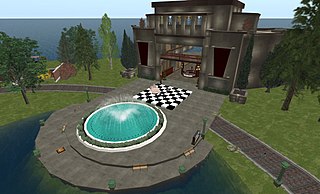Poser is a figure posing and rendering 3D computer graphics program distributed by Bondware. Poser is optimized for the 3D modeling of human figures. It enables beginners to produce basic animations and digital images, along with the extensive availability of third-party digital 3D models.
2.5D perspective refers to gameplay or movement in a video game or virtual reality environment that is restricted to a two-dimensional (2D) plane with little to no access to a third dimension in a space that otherwise appears to be three-dimensional and is often simulated and rendered in a 3D digital environment.

Quake Army Knife (QuArK), is a free and open-source program for developing 3D assets for a large variety of first-person shooters, such as video games using the Quake engine by id Software or the Torque engine.

In video games, a level is any space available to the player during the course of completion of an objective. Video game levels generally have progressively increasing difficulty to appeal to players with different skill levels. Each level may present new concepts and challenges to keep a player's interest high.

Autodesk Softimage, or simply Softimage was a 3D computer graphics application, for producing 3D computer graphics, 3D modeling, and computer animation. Now owned by Autodesk and formerly titled Softimage|XSI, the software has been predominantly used in the film, video game, and advertising industries for creating computer generated characters, objects, and environments.

Google Earth is a web and computer program that renders a 3D representation of Earth based primarily on satellite imagery. The program maps the Earth by superimposing satellite images, aerial photography, and GIS data onto a 3D globe, allowing users to see cities and landscapes from various angles. Users can explore the globe by entering addresses and coordinates, or by using a keyboard or mouse. The program can also be downloaded on a smartphone or tablet, using a touch screen or stylus to navigate. Users may use the program to add their own data using Keyhole Markup Language and upload them through various sources, such as forums or blogs. Google Earth is able to show various kinds of images overlaid on the surface of the Earth and is also a Web Map Service client. In 2019, Google revealed that Google Earth now covers more than 97 percent of the world, and has captured 10 million miles of Street View imagery.

Mario Artist is an interoperable suite of three games and one Internet application for Nintendo 64: Paint Studio, Talent Studio, Polygon Studio, and Communication Kit. These flagship disks for the 64DD peripheral were developed to turn the game console into an Internet multimedia workstation. A bundle of the 64DD unit, software disks, hardware accessories, and the Randnet online service subscription package was released in Japan starting in December 1999.

A virtual museum is a digital entity that draws on the characteristics of a museum, in order to complement, enhance, or augment the museum experience through personalization, interactivity, and richness of content. Virtual museums can perform as the digital footprint of a physical museum, or can act independently, while maintaining the authoritative status as bestowed by the International Council of Museums (ICOM) in its definition of a museum. In tandem with the ICOM mission of a physical museum, the virtual museum is also committed to public access; to both the knowledge systems embedded in the collections and the systematic, and coherent organization of their display, as well as to their long-term preservation. As with a traditional museum, a virtual museum can be designed around specific objects, or can consist of online exhibitions created from primary or secondary resources. Moreover, a virtual museum can refer to the mobile or World Wide Web offerings of traditional museums ; or can be born digital content such as, 3D environments, net art, virtual reality and digital art. Often, discussed in conjunction with other cultural institutions, a museum by definition, is essentially separate from its sister institutions such as a library or an archive. Virtual museums are usually, but not exclusively delivered electronically when they are denoted as online museums, hypermuseum, digital museum, cybermuseums or web museums.

Graphic art software is a subclass of application software used for graphic design, multimedia development, stylized image development, technical illustration, general image editing, or simply to access graphic files. Art software uses either raster or vector graphic reading and editing methods to create, edit, and view art.

3D computer graphics, sometimes called CGI, 3-D-CGI or three-dimensional computer graphics, are graphics that use a three-dimensional representation of geometric data that is stored in the computer for the purposes of performing calculations and rendering digital images, usually 2D images but sometimes 3D images. The resulting images may be stored for viewing later or displayed in real time.

A 3D city model is digital model of urban areas that represent terrain surfaces, sites, buildings, vegetation, infrastructure and landscape elements in three-dimensional scale as well as related objects belonging to urban areas. Their components are described and represented by corresponding two- and three-dimensional spatial data and geo-referenced data. 3D city models support presentation, exploration, analysis, and management tasks in a large number of different application domains. In particular, 3D city models allow "for visually integrating heterogeneous geoinformation within a single framework and, therefore, create and manage complex urban information spaces."

Computer graphics deals with generating images and art with the aid of computers. Computer graphics is a core technology in digital photography, film, video games, digital art, cell phone and computer displays, and many specialized applications. A great deal of specialized hardware and software has been developed, with the displays of most devices being driven by computer graphics hardware. It is a vast and recently developed area of computer science. The phrase was coined in 1960 by computer graphics researchers Verne Hudson and William Fetter of Boeing. It is often abbreviated as CG, or typically in the context of film as computer generated imagery (CGI). The non-artistic aspects of computer graphics are the subject of computer science research.
Simplygon is 3D computer graphics software for automatic 3D optimization, based on proprietary methods for creating levels of detail (LODs) through Polygon mesh reduction and other optimization techniques.
Game art design is a subset of game development involving the process of creating the artistic aspects of video games. Video game art design begins in the pre-production phase of creating a video game. Video game artists are visual artists involved from the conception of the game who make rough sketches of the characters, setting, objects, etc. These starting concept designs can also be created by the game designers before the game is moved into actualization. Sometimes, these concept designs are called "programmer art". After the rough sketches are completed and the game is ready to be moved forward, those artists or more artists are brought in to develop graphic designs based on the sketches.
PICA200 is a graphics processing unit (GPU) designed by Digital Media Professionals Inc. (DMP), a Japanese GPU design startup company, for use in embedded devices such as vehicle systems, mobile phones, cameras, and game consoles. The PICA200 is an IP Core which can be licensed to other companies to incorporate into their SOCs. It was most notably licensed for use in the Nintendo 3DS.

Away3D is an open-source platform for developing interactive 3D graphics for video games and applications, in Adobe Flash or HTML5. The platform consists of a 3D world editor, a 3D graphics engine, a 3D physics engine and a compressed 3D model file format (AWD).

Mountains is an image analysis and surface metrology software platform published by the company Digital Surf. Its core is micro-topography, the science of studying surface texture and form in 3D at the microscopic scale. The software is dedicated to profilometers, 3D light microscopes ("MountainsMap"), scanning electron microscopes ("MountainsSEM") and scanning probe microscopes ("MountainsSPIP").

In 3D computer graphics, 3D modeling is the process of developing a mathematical coordinate-based representation of a surface of an object in three dimensions via specialized software by manipulating edges, vertices, and polygons in a simulated 3D space.
Stage3D is an Adobe Flash Player API for rendering interactive 3D graphics with GPU-acceleration, within Flash games and applications. Flash Player or AIR applications written in ActionScript 3 may use Stage3D to render 3D graphics, and such applications run natively on Windows, Mac OS X, Linux, Apple iOS and Google Android. Stage3D is similar in purpose and design to WebGL.

Babylon.js is a JavaScript library and 3D engine for displaying real time 3D graphics in a web browser via HTML5. The source code is available on GitHub and distributed under the Apache License 2.0.










